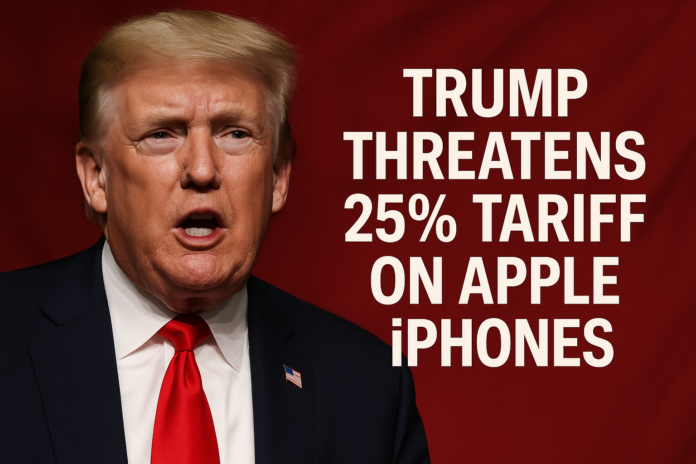Apple gets hit for the fifth time by Donald Trump. This time he threatens to put a 25% tariff on iPhones that aren’t made in the US. Trump has said publicly, with several recent statements and a Truth Social post, that Apple is one of a handful of companies that he expects to move production of iPhones from overseas facilities in China and India to American soil.
Warning to Apple and Tim Cook
Trump also said that he told Apple CEO Tim Cook face-to-face to stop building its iPhone in India. Former president insisted that any iPhone made here in the U.S. had to be made domestically and not abroad. “The position is consistent with Perez’s long-held ‘America First’ philosophy and his emphasis on domestic manufacturing and a reduction from foreign supply chains,” CNBC reported.
Trump’s threat of a tariff is part of a wider bid to pressure American companies with big workforces to bring jobs and manufacturing capacity home to America. And it could work as he ramps up rhetorical support for his 2024 campaign with economic nationalism still at the cavernous center.
Also read: Trump Delays EU Tariffs Amid Trade Talks With Von der Leyen
Why “Made in America” iPhones Are Complicated
Though Trump’s suggestion might seem patriotic, experts say that assembling iPhones in the United States is practically impossible in the short term. Over 80 percent of iPhones are currently assembled in China in high-speed production ecosystems that the suppliers, of which Foxconn is the largest, maintain. These facilities could mobilize tens of thousands of workers and turn around millions of units quickly, something not now feasible in the U.S.
Last year, Apple CEO Tim Cook previously said that the U.S. did not have the skilled manufacturing labor capacity to scale up manufacturing of the iPhone. Of course, countries such as China and Taiwan have far more key roles, such as tooling engineers.
Failed Attempts and Global Alternatives
In contrast, an earlier push to begin making the products stateside came up short. Foxconn’s trumpeted $10 billion Wisconsin factory, touted during Trump’s first term, turned out a far more modest number of jobs and goods than the company and the administration had promised. The plant was intended to employ 13,000 people, but finished with fewer than 1,500 workers and did not make high tech electronics at scale.
Apple, meanwhile, has shifted to making India an increasing replacement for China. Today, India accounts for roughly 15 per cent of global iPhone production, almost all of which comes through final assembly. Lower labor costs, government incentives, and a growing consumer market are what the country offers. But as with the U.S., India is dependent on imported parts.
Also read: Ford Hikes Prices on Mexico-Made Vehicles Amid U.S. Tariffs
Limited U.S. Production Isn’t Enough
Under U.S. political pressure, Apple has made a few concessions. But the company has a small number of Mac Pro units assembled in Texas and it keeps investing in chip design and AI development in the U.S. But none of these projects are large enough to compare with Apple’s huge global supply chain.
But experts say Trump’s tariff threat is more likely to raise iPhone prices for American consumers than bring production back to the U.S. because such an initiative has proved costly in the past. Until now, Apple has yet to comment on the proposed tariffs.








